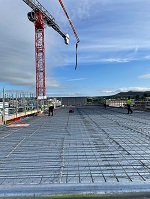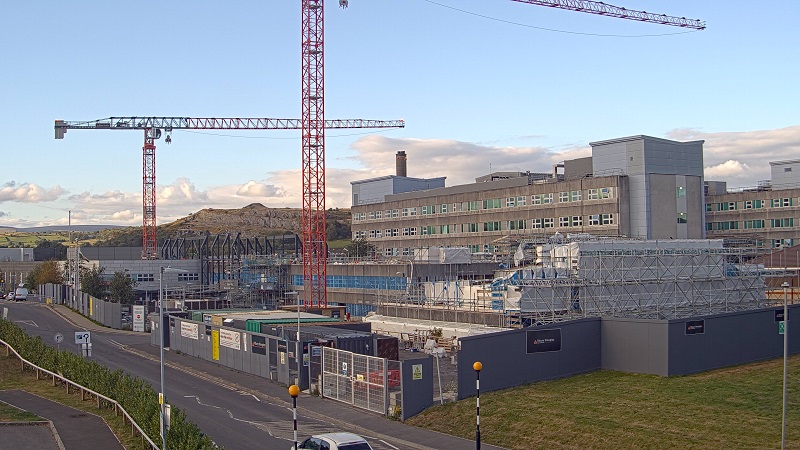As the original contractor which built the hospital back in 1972-75, Tilbury Douglas’ involvement with the site is far reaching and we are now the lead contractor on the £130m refurbishment scheme.
This means we have the responsibility for modernising the hospital and making it suitable for the longer-term, a project which involves upgrading and extending the facilities over several phases, which first started on site in 2017, with completion currently planned for June 2026.
The overall scheme includes the construction of departments, roofs, atriums, two main entrances, hydrotherapy pools, several new plant rooms, updating car parks – and much more – all while the hospital remains operational.
In order to make this all possible, we have an experienced team with an average of 150 people working on site every day.
And we recently reached an incredible milestone, with more than a million recorded hours worked on the scheme already.
We use a very large variety of plant across the project, including excavators and dumpers on the car park works.

For the ground-floor refurbishment, we use electric excavators and dumpers to remove existing structural floor slabs. We also have two tower cranes assisting where needed that are 30m and 40m high (pictured right).
Now working on phase two, we are currently focusing on the completion of four asbestos enclosures, which are physical barriers around the asbestos work area which will safely contain the asbestos dust and waste.
These cover 3,500 sq m of the live hospital, including the new footprint for the theatres department, which requires its roof to be raised.
As the original hospital was built back in the 1970s, headroom requirements were much lower than modern proportions. Therefore, we are having to build a new raised roof for the department and then demolish the old one, which will be underneath it, all while the lower floor of the hospital remains operational.
Once we have constructed the new raised roof, and while we are demolishing the lower old one, we will be building a big plantroom over the top that is independent to the main building.
This creates a large space that will house mechanical and electrical plant and equipment necessary for a modern hospital to function.
As part of the asbestos enclosures, another key focus for us is the removal of the old concrete cladding panels, with each one weighing up to five tonnes. This is required where extensions are being added onto the existing building. The panels themselves do not contain asbestos, but they have been contaminated from spray coating from the original build.
To remove them safely, we firstly needed a specialist scaffold design to be produced to take the weight of the scaffolding panels that we are removing, but also to create the asbestos enclosure. Before it was erected and checked, the design was signed off by temporary works engineers.
The asbestos enclosure was then built around this to create a sealed enclosure, which is under negative pressure.
The existing concrete panels span 6.6m between the existing steel columns, so when it comes to removal, straps are wrapped around the panels which are fixed to a series of chain blocks attached to the scaffold structure above.
The chain blocks take the weight of the panels prior to the fixing points being broken off. At this point the scaffold is the only thing holding up the concrete panel. This is then carefully lowered to the ground by slowly letting down the chain blocks simultaneously. Once placed on timber bearers, they are then broken into manageable pieces and bagged as asbestos waste.
At the same time, on the original outpatients department on the ground floor, we are having to strip back and take out entire ground-floor slabs for various reasons, including drainage or foundation strengthening and then replace these with new ones before fitting out the spaces.
To add to the challenges, we are also having to add additional bracing to improve the lateral stability of the building while the site remains operational. This is difficult as when we add a braced bay it needs to be on both the ground and first floors directly inline.
The process is obviously easier when this is in within our construction area, but much harder when it has been within live areas that we are not supposed to be working in at any point.
Therefore, the process involves taking occupation of a number of rooms that interface with the specific column locations and then removing any necessary furniture, ceilings, and walls, as well as carryout service isolation.

The work by Tilbury Douglas, due for completion in 2026, includes upgrading and extending facilities
We then set up asbestos enclosures around the columns to break off the concrete that encases the steel column underneath. We must do this as some of the columns have been found with asbestos spray coating underneath the concrete.
Once this concrete has been removed and four-stage clearance achieved from asbestos works, the steel fabricators can take accurate dimensions.
Next, the steel bracing is installed within the bay, between two columns, and then, finally, work is carried out to put the room back into use.
Live environments
Working within a live environment, which hundreds of patients and staff are using on a daily basis, can be a challenge, but one we have overcome by ensuring we collaborate closely with all parties.
Having phasing plans in place for many years allows us to create decant spaces. This has included the introduction of modular buildings and refurbished outpatients and therapies departments relocated into other blocks to allow the live environments to continue to run efficiently.
Working very closely with all stakeholders has been a key element to the ongoing success of this scheme.
There is very-close liaison with the hospital, and we have a strong relationship with the health board. Meetings take place on a monthly, weekly, and even daily, basis with various stakeholders.
This also includes collaboration with our colleagues in Tilbury Douglas Engineering while they focus on the major engineering works.
Currently, they are working on the major temporary infrastructure routes across the hospital, prior to stripping out the dilapidated existing infrastructure from with the service tunnels. This then allows the team to add new supplies back which connect to the switch rooms and plant rooms.
Looking ahead, we will be completing the first phase of the new pathology department at the end of this year. We will then be moving into the radiology department.
Following on from our current projects, there will be more works to theatres, pathology, radiology, critical care, and then a new MRI unit.
We are proud to be working collaboratively to build and upgrade a hospital which will serve the community for many decades and generations to come.

